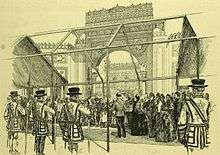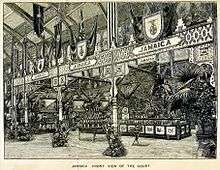Colonial and Indian Exhibition


_-_BL.jpg)
The Colonial and Indian Exhibition of 1886 was a very substantial exhibition held in South Kensington in London, and intended (in the words of the then Prince of Wales) "to stimulate commerce and strengthen the bonds of union now existing in every portion of her Majesty's Empire".[2] The exhibition was opened by Queen Victoria, and when it closed had received 5.5 million visitors.[3]
It was housed in a collection of purpose-built buildings designed in an Indian style.
Display
Exhibits shown included a Māori tomb from New Zealand,[4] a ceremonial sword from the colony of Lagos,[5] a grasshopper swatter from the Straits Settlements,[6] and Albert Bierstadt's painting of the Bahama Islands After A Norther was displayed in the West Indian gallery, and admired by the Prince of Wales[7]
The India artware section was split into different areas representing the different princely states. The Rajputana entrance was a large Jaipur gate constructed of and provided by the then Maharaja of Jaipur.[3] The Gwalior gateway which had been displayed at the Calcutta International Exhibition (1883) was loaned by the Victoria and Albert Museum.[8]
Several dozen Indians were imported, reputedly from Agra jail,[9] to serve as living exhibits; they were described as artisans, it appears that they were trained in their crafts as part of the British Empire's long-term project to 'reform the criminal castes'.
Legacy
The Jaipur Gate built for the exhibition was renovated in 2004, and is on display at the Hove Museum and Art Gallery[3]
References
- ↑ The Illustrated London News, 8 May 1886, p. 478.
- ↑ Saloni Mathur, India by Design: Colonial History and Cultural Display (Berkeley: U of California P, 2007), p.57.
- 1 2 3 "The Jaipur Gate". Retrieved 12 March 2012.
- ↑ "British Museum - Search object image". Retrieved 12 March 2012.
- ↑ "British Museum - Search object details". Retrieved 12 March 2012.
- ↑ "British Museum - Search object details". Retrieved 12 March 2012.
- ↑ "The Haggin Museum - Collections: Art: Albert Bierstadt: After Norther, Bahamas". Retrieved 4 April 2012.
- ↑ "Photographic guardbooks: Images of India | Victoria and Albert Museum". Retrieved 4 January 2017.
- ↑ Mathur, Saloni (2007). India by Design: Colonial History and Cultural Display. University of California Press. p. 60. ISBN 9780520234178. OCLC 76481430. Retrieved 13 January 2015.
External links
| Wikimedia Commons has media related to Colonial and Indian Exhibition. |
- Photograph of a Maori tomb on display at the exhibition
- Illustration of the Jaipur Gate at the time of the exhibition
- The British Museum collection database - enter "The Colonial and Indian Exhibition" for a list of objects from the exhibition in the British Museum collection
- Colonial and Indian Exhibition, 1886 Official Catalogue. London: William Clowes and Sons. 1886. ISBN 0665052553. Retrieved 13 January 2015.